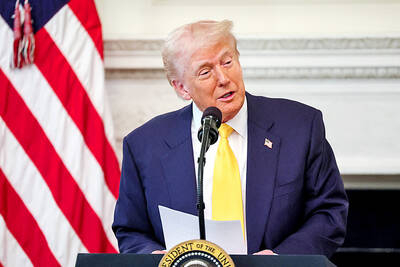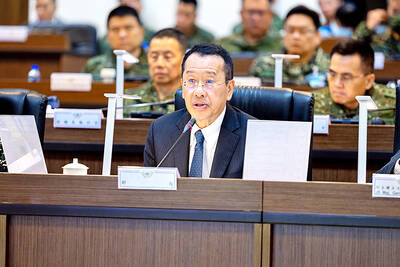Student protesters clashed with police several times yesterday, pulling down a steel gate outside the Legislative Yuan as they tried to force their way into a public hearing on the cross-strait service trade pact after their request to attend the meeting was turned down.
Arriving before the start of the public hearing at the legislature’s Internal Administration Committee at 9am, more than 100 students representing over a dozen universities across the nation rallied outside the legislature, asking that they be let in when greeted by closed gates and rows of police officers with shields.
The students tried to negotiate by presenting a list of representatives, hoping that at least a few of them would be allowed into the meeting, but their request was turned down by Chinese Nationalist Party (KMT) Legislator Johnny Chiang (江啟臣), who presided over the meeting.

Photo: Lo Pei-der, Taipei Times
“We are students now, but in a few years, we will be graduating and will join the work force; hence, the service trade agreement could have an impact on our future employment. This is why we want to take part in the meeting, to listen and to express our opinions,” National Taiwan University (NTU) student Huang Shou-ta (黃守達) told the crowd. “In fact, this is something that could affect everyone in this country. The public should be allowed to take part in the public hearing, instead of having only a number of businesspeople who would benefit from it and academics who support the agreement at the meeting.”
“We are citizens of this country. Taking part in a public hearing and discussing public policy is our right,” said Lin Fei-fan (林飛帆), another NTU student.
However, as the legislature failed to respond positively to their request, the protesters grew impatient.
At 9:08am, some of the students tried to climb over the gate, while the rest chanted: “Open the gate!”
Police on the other side of the gate tried to push them back, but about 20 protesters, with the help of fellow students, managed to get in. However, they were quickly tackled by officers and escorted out after police took down their names.
The students did not give up, and an hour later, made a second attempt to get in.
While the police were on full alert this time, some of the protesters managed to pull down part of the gate and rushed toward the legislative building.
Another round of pushing and shoving ensued, with several protesters saying they were injured and later sent to hospital. Those who got in were also soon dealt with.
“These young student absolutely have the right to have a say about the agreement, because they are the ones who will have to shoulder the consequences in the next 50 years or so,” said Frida Tsai (蔡培慧), an assistant professor at Shih Hsin University who came to support her students. “Police in a democratic country should help defend the democracy, not a government that sells out public interests.”
“Free trade benefits only capitalists and big corporations, never the people — just look at how our lives have not gotten better after Taiwan joined the WTO,” she added.

STILL COMMITTED: The US opposes any forced change to the ‘status quo’ in the Strait, but also does not seek conflict, US Secretary of State Marco Rubio said US President Donald Trump’s administration released US$5.3 billion in previously frozen foreign aid, including US$870 million in security exemptions for programs in Taiwan, a list of exemptions reviewed by Reuters showed. Trump ordered a 90-day pause on foreign aid shortly after taking office on Jan. 20, halting funding for everything from programs that fight starvation and deadly diseases to providing shelters for millions of displaced people across the globe. US Secretary of State Marco Rubio, who has said that all foreign assistance must align with Trump’s “America First” priorities, issued waivers late last month on military aid to Israel and Egypt, the

‘UNITED FRONT’ FRONTS: Barring contact with Huaqiao and Jinan universities is needed to stop China targeting Taiwanese students, the education minister said Taiwan has blacklisted two Chinese universities from conducting academic exchange programs in the nation after reports that the institutes are arms of Beijing’s United Front Work Department, Minister of Education Cheng Ying-yao (鄭英耀) said in an exclusive interview with the Chinese-language Liberty Times (the Taipei Times’ sister paper) published yesterday. China’s Huaqiao University in Xiamen and Quanzhou, as well as Jinan University in Guangzhou, which have 600 and 1,500 Taiwanese on their rolls respectively, are under direct control of the Chinese government’s political warfare branch, Cheng said, citing reports by national security officials. A comprehensive ban on Taiwanese institutions collaborating or

France’s nuclear-powered aircraft carrier and accompanying warships were in the Philippines yesterday after holding combat drills with Philippine forces in the disputed South China Sea in a show of firepower that would likely antagonize China. The Charles de Gaulle on Friday docked at Subic Bay, a former US naval base northwest of Manila, for a break after more than two months of deployment in the Indo-Pacific region. The French carrier engaged with security allies for contingency readiness and to promote regional security, including with Philippine forces, navy ships and fighter jets. They held anti-submarine warfare drills and aerial combat training on Friday in

COMBAT READINESS: The military is reviewing weaponry, personnel resources, and mobilization and recovery forces to adjust defense strategies, the defense minister said The military has released a photograph of Minister of National Defense Wellington Koo (顧立雄) appearing to sit beside a US general during the annual Han Kuang military exercises on Friday last week in a historic first. In the photo, Koo, who was presiding over the drills with high-level officers, appears to be sitting next to US Marine Corps Major General Jay Bargeron, the director of strategic planning and policy of the US Indo-Pacific Command, although only Bargeron’s name tag is visible in the seat as “J5 Maj General.” It is the first time the military has released a photo of an active